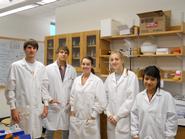
Piscidin is an antimicrobial peptide found in hybrid striped bass which binds to cell membranes in order to destroy them. Victoria Bogen ’14, Robert Hayden ’14, Akritee Shrestha ’13, Leah Cairns ’13 and Christopher Rider ’12 are working with Associate Professor of Chemistry Myriam Cotten to conduct research on piscidin. Their research aims to solve the peptide’s structure and behavior in various conditions.
Bogen’s and Rider’s summer research was funded through the Edward and Virginia Taylor Fund for Student/Faculty Research in Chemistry, established in 2008 through a gift from Ted ’46 and Virginia to inspire students interested in chemical research and to facilitate their work with outstanding faculty.
Peptides such as piscidin destroy cells by binding to the cell’s surface and breaking it open, killing the bacteria. It remains unclear exactly how piscidin moves and binds to bacteria and how the peptide is oriented in space. Cotten’s group is advancing research from previous senior theses and summer research to study piscidin from several different angles.
The group is conducting experiments using membranes made of various lipid systems that mimic cell membranes. They prepare these lipid membranes in the lab, essentially producing empty cells. When piscidin is added to the membranes, various data can reveal information about the peptide’s behavior. There are several forms of piscidin, and group members are working with piscidin 1 and piscidin 3.
Bogen is comparing piscidin 1 with neuropeptide Y (NPY) with regard to how the depth of insertion of each peptide in the membrane and the peptide’s movement in the bacterial cell membrane cause cell death. She will also be using dye leakage assays to determine which is more effective at lysing bacterial cell mimics.
Shrestha’s project involves studying two types of lipid systems’ interactions with piscidin; one system mimics bacterial cell membranes while the other mimics yeast cell membranes. Piscidin has been found to be more effective at killing bacterial cells than yeast cells, and Shreshtha aims to see whether the primary lipid components of these cell membranes and the difference in their peptide-binding abilities affects the peptide’s activity.
Cairns is also comparing two lipid systems: she is working with membranes that mimic mammalian and bacterial cells to test for the influence of cholesterol on piscidin 3’s activity. While piscidin is active against bacterial cells, it is inactive towards mammalian cells. The major difference between these systems is that mammalian membranes contain cholesterol and bacterial membranes do not. Cairns is introducing cholesterol into her membranes to determine if cholesterol is the cause of piscidin’s reduced effectiveness on mammalian cells.
Part of Hayden’s project is to confirm Cairns’s results through dye leakage tests, a process which involves placing dye into cells and measuring how much leaks out when the cell membranes break. In this case, the group expects to see more dye leakage from membranes without any added cholesterol. Hayden will also use solid state NMR (ssNMR) techniques to help understand the structure of piscidin 1.
Rider’s research involves a titration of piscidin in solution. By gradually changing the pH of the solution, he hopes to learn about how the peptide’s structure changes in response to pH levels. When piscidin binds to a cell membrane, it is unclear how deeply it pierces the membrane and what its structure looks like during this process. Rider hopes that his research will shed light on how pH affects piscidin’s behavior as it binds to cell membranes.
Some of the instruments necessary for the project are unavailable at Hamilton, so the group is traveling to Upstate Medical University in Syracuse to use a circular dichroism spectrometer and to the National High Magnetic Field Laboratory at Florida State University in Tallahassee to use high-powered NMR instruments.
As drug-resistant bacteria become more widespread, novel methods must be explored to fight them. The study of antimicrobial peptides such as piscidin has the potential to contribute much to this field. By finding out more about piscidin’s structure, movements and how it interacts with cell membranes, Professor Cotton’s team is helping to advance current knowledge on this peptide and all antimicrobial peptides.
Akritee Shrestha is a graduate of Saint Xavier’s High School in Kathmandu, Nepal; Leah Cairns graduated from Andover High School (Mass.); Chris Rider is a graduate of Cook County High School ( Minn.); Victoria Bogen graduated from Grosse Pointe North High School (Mich.); Robert Hayden is a graduate of Pittsford Sutherland High School (N.Y.).
Posted August 12, 2011
